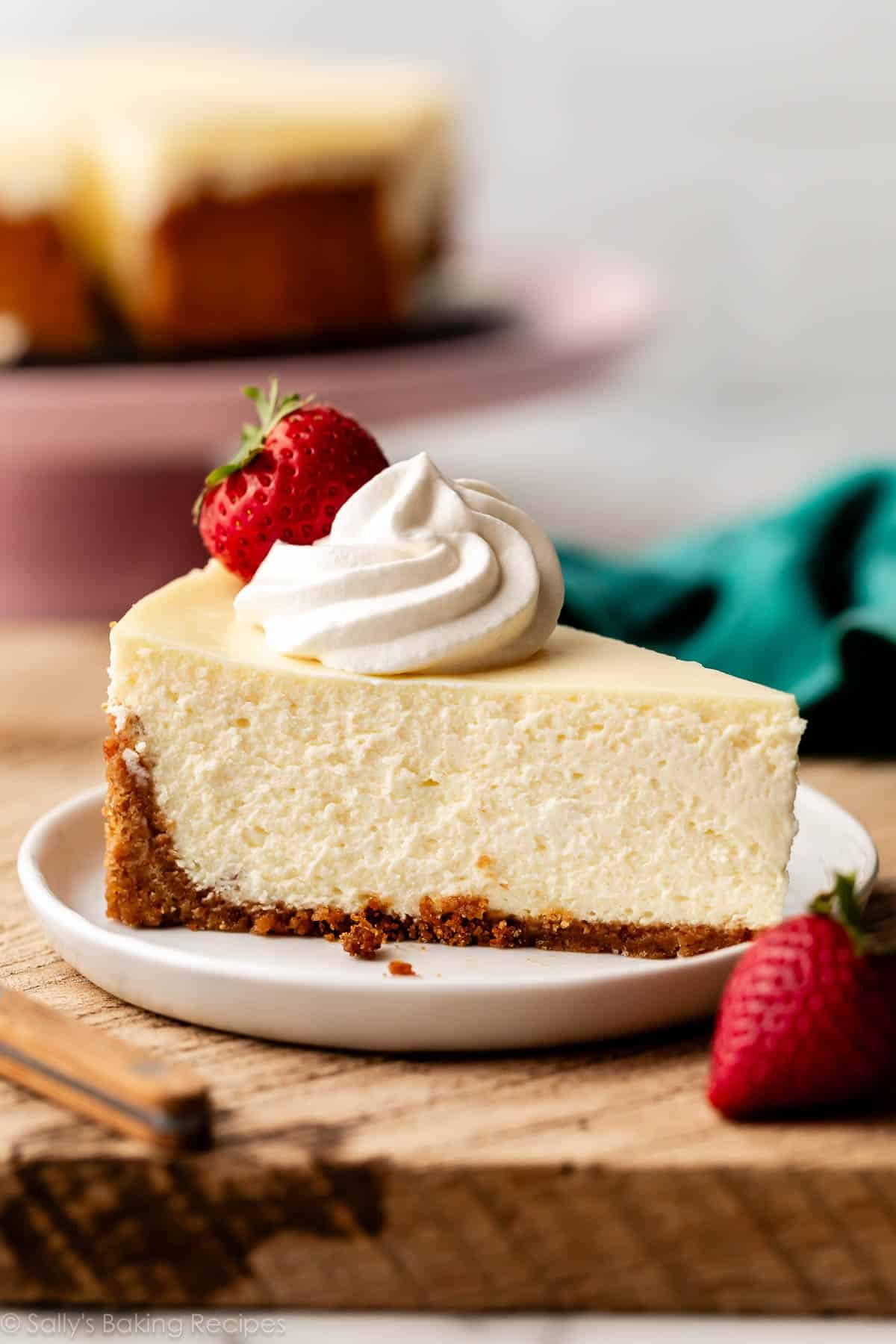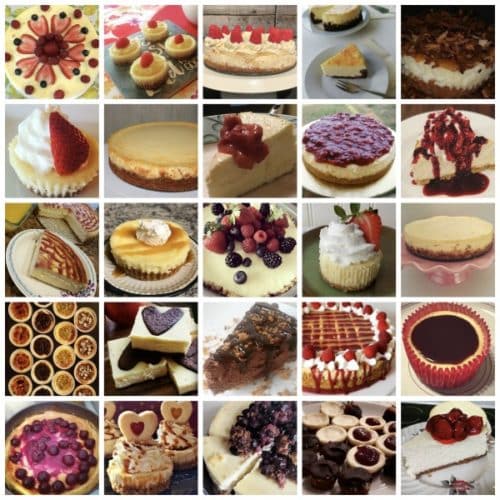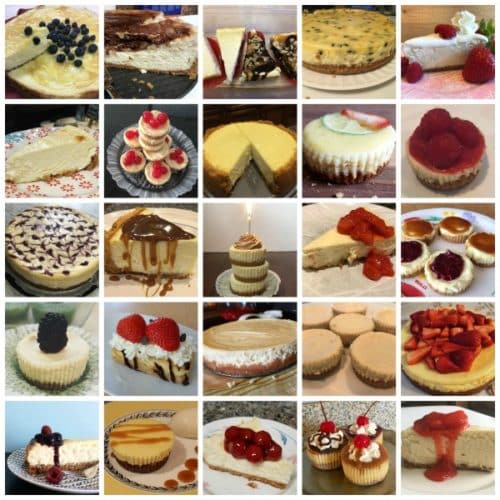Look no further for a creamy and ultra smooth classic cheesecake recipe! Paired with a buttery graham cracker crust, no one can deny its simple decadence. For the best results, bake in a water bath.

Not a Plain Cheesecake Recipe
As much as I love cheesecake, I’ve never published a classic cheesecake recipe. There’s been peanut butter cheesecake, blueberry swirl cheesecake, Snickers cheesecake, pumpkin swirl cheesecake, lemon cheesecake, caramel turtle cheesecake, or Amaretto cheesecake. Plus more cheesecake in my published cookbooks. That’s a lot of cheesecake recipes without a single nod to where it all originates: classic cheesecake.
To me, classic cheesecake is creamy, rich, and smooth. My cheesecake recipe is not as dense as New York cheesecake, but it’s just as special. It’s thick, it’s velvety, and there’s no denying its decadence. When I imagine what Chandler and Rachel’s stolen cheesecake tastes like, it’s this!
While there’s a glaring absence of chunks, swirls, and sprinkles in this ivory crowned jewel, there’s nothing plain about it.


Preparing my cheesecake recipe is rather simple—it’s baking the cheesecake that could result in a flop. Many factors are at play like the springform pan leaking, the surface of the cheesecake cracking, under-baking, over-baking, etc. I have plenty of tricks that will help guarantee classic cheesecake perfection, including determining when the cheesecake is done and everything you need to know about a cheesecake water bath.

How to Make Classic Cheesecake
You only need a few basic staple ingredients for this cheesecake recipe.
- Brick cream cheese: Four 8-ounce bricks of full-fat cream cheese are the base of this cheesecake. That’s 2 pounds. Make sure you’re buying the bricks of cream cheese and not cream cheese spread. There are no diets allowed in cheesecake, so don’t pick up the reduced-fat variety!
- Sugar: 1 cup. Not that much considering how many mouths you can feed with this dessert. Over-sweetened cheesecake is hardly cheesecake anymore. Using only 1 cup of sugar gives this cheesecake the opportunity to balance tangy and sweet, just as classic cheesecake should taste.
- Sour cream: 1 cup. I recently tested a cheesecake recipe with 1 cup of heavy cream instead, but ended up sticking with my original (which can be found here with blueberry swirl cheesecake!). I was curious about the heavy cream addition and figured it would yield a softer cheesecake bite. The cheesecake was soft, but lacked the stability and richness I wanted. It was almost too creamy. Sour cream is most definitely the right choice.
- A little flavor: 1 teaspoon of pure vanilla extract and 2 of lemon juice. The lemon juice brightens up the cheesecake’s overall flavor and vanilla is always a good idea.
- Eggs: 3 eggs are the final ingredient. You’ll beat the eggs in last, one at a time, until they are *just* incorporated. Do not overmix the batter once the eggs are added. This will whip air into the cheesecake batter, resulting in cheesecake cracking and deflating.
And as always, make sure all of the cheesecake batter ingredients are at room temperature so the batter remains smooth, even, and combines quickly. Beating cold ingredients together will result in a chunky over-beaten cheesecake batter, hardly the way we want to start!
How to Make a Graham Cracker Crust
Since classic is the keyword of the day, we’re sticking with cheesecake’s main squeeze: a graham cracker crust. I reduced the butter from my original graham cracker crust recipe by 1 Tablespoon. I find this crust remains a little more crunchy. Make sure you pack the crust in tight and pre-bake it to help prevent any sogginess.
You could use this Oreo cookie crust instead. No big changes necessary to the recipe below, but I do encourage you to lightly grease the bottom of the springform pan because Oreo crusts tend to stick. Or you could use a Biscoff pie crust instead if you’d like.
I like to use the bottom of a small measuring cup to smooth the crust mixture into the springform pan. Speaking of, you’ll need a 9-inch or 10-inch springform pan. A springform pan has removable sides so you can safely release the cheesecake without having to flip the pan over or struggle to cut the cheesecake inside the pan. Springform pans can leak if you’re baking the cheesecake in a water bath (more on that below!), but this particular pan is reliable. I haven’t had any leaking issues.


Cheesecake Water Bath
I promise a water bath is nothing complicated. All you’re doing is placing the springform pan in a roasting pan, filling it with hot water, and baking. What’s the point, you ask?
I actually have an entire post and video tutorial for How to Make a Cheesecake Water Bath.
You see, cheesecake loves a humid environment. The steam from the hot water will lift the cheesecake up slowly and evenly, reducing the risk of cracks on the surface. Additionally, this slow and even baking method helps prevent the cheesecake from sinking back down as it cools. Taking a few extra minutes to prepare a water bath for this cheesecake recipe is well worth it.
Cooling & Chilling Cheesecake
Another way to help prevent cheesecake cracks is to initially cool it inside the oven. You can see me do this in the video below. When the cheesecake is done, turn the oven off, crack open the oven door, and leave the cheesecake inside for 1 hour. A drastic and sudden change of temperature isn’t ideal for cheesecake—from hot oven to cool counter—so do your best to control the environment by leaving the cheesecake inside. Does this make sense?
After the cheesecake cools in the oven for 1 hour, place it on the counter to cool. After it’s cool, chill it in the refrigerator for at least 4 hours or even overnight. There’s no greater test to your willpower than those several hours you’re forced to wait as the cheesecake cools down and then chills in the refrigerator. But every minute is completely worth it when you take that first luscious bite.
For a quicker, easier alternative to making a classic cheesecake, try this cheesecake pie or pumpkin cheesecake pie. Or if you want to completely skip the baking and cooling process, try my no-bake cheesecake instead.


4 Success Tips for Perfect Cheesecake
To summarize, here are some tricks I discussed:
- Do not over-mix the cheesecake batter.
- Bake in a water bath.
- Leave cheesecake in the cooling oven for 1 hour.
- Cool completely at room temperature.
Cheesecake Toppings
Enjoy your velvet-rich cheesecake as is or get a little fancy with a selection of toppings. I love cheesecake best with fruit, so I serve it with this simple raspberry sauce. Or you could top with homemade lemon curd, chocolate ganache, salted caramel, strawberry topping, blueberry sauce topping, or homemade whipped cream. Get creative or keep it simple. Either way, it’s going to impress. (And you’d totally eat it off the floor… Chandler and Rachel style.)
If you’re really looking to take your toppings to the next level, check out my pecan pie cheesecake or caramel apple cheesecake pie.

How to Freeze Cheesecake
- Cool the cheesecake on the counter before freezing. No need to chill it in the refrigerator.
- Freeze on springform pan: Remove the outer rim from the springform pan. Wrap the cheesecake with the bottom of the pan with a few layers of plastic wrap, then a final layer of aluminum foil.
- Freeze without springform pan: After the cheesecake has completely cooled, run a sharp knife underneath the crust to release it from the bottom of the pan. Carefully slide it onto a parchment paper lined piece of cardboard or use a plate. Wrap it all in a few layers of plastic wrap, then a final layer of aluminum foil.
- Freeze for up to 3 months, then thaw overnight in the refrigerator before serving.
- Do not freeze cheesecake with any toppings. Add toppings, like homemade whipped cream or salted caramel, when serving cheesecake.
Reader Photos!
Feel free to email or share your recipe photos with us on social media. 🙂
Print
Best Classic Cheesecake Recipe
- Prep Time: 45 minutes
- Cook Time: 1 hour
- Total Time: 7 hours, 45 minutes (includes chilling)
- Yield: serves 12-16
- Category: Dessert
- Method: Baking
- Cuisine: American
Description
Look no further for a creamy and ultra smooth classic cheesecake recipe! Paired with a buttery graham cracker crust, no one can deny its simple decadence. For the best results, bake in a water bath.
Ingredients
Graham Cracker Crust
- 1 and 1/2 cups (180g) graham cracker crumbs (about 12 full sheet graham crackers)
- 1/4 cup (50g) granulated sugar
- 5 Tablespoons (71g) unsalted butter, melted
Cheesecake
- 32 ounces (904g) full-fat brick cream cheese, softened to room temperature
- 1 cup (200g) granulated sugar
- 1 cup (240g) full-fat sour cream, at room temperature
- 1 teaspoon pure vanilla extract
- 2 teaspoons fresh lemon juice (optional, but recommended)
- 3 large eggs, at room temperature
Instructions
- Adjust the oven rack to the lower-middle position and preheat oven to 350°F (177°C).
- Make the crust: If you’re starting out with full graham crackers, use a food processor or blender to grind them into fine crumbs. Pour into a medium bowl and stir in sugar until combined, and then stir in the melted butter. Mixture will be sandy. Try to smash/break up any large chunks. Pour into an ungreased 9-inch or 10-inch springform pan. With medium pressure using your hand, pat the crumbs down into the bottom and partly up the sides to make a compact crust. Do not pack down with heavy force because that makes the crust too hard. Simply pat down until the mixture is no longer crumby/crumbly and you can use the flat bottom of a small measuring cup to help smooth it all out if needed. Pre-bake for 10 minutes. Remove from the oven and place the hot pan on a large piece of aluminum foil. The foil will wrap around the pan for the water bath in step 4. Allow crust to slightly cool as you prepare the filling.
- Make the filling: Using a handheld or stand mixer fitted with a paddle attachment, beat the cream cheese and granulated sugar together on medium-high speed in a large bowl until the mixture is smooth and creamy, about 2 minutes. Add the sour cream, vanilla extract, and lemon juice then beat until fully combined. On medium speed, add the eggs one at a time, beating after each addition until just blended. After the final egg is incorporated into the batter, stop mixing. To help prevent the cheesecake from deflating and cracking as it cools, avoid over-mixing the batter as best you can. You will have close to 6 cups of batter.
- Prepare the simple water bath (see note): If needed for extra visuals, see my How to Make a Cheesecake Water Bath; the visual guide will assist you in this step. Boil a pot of water. You need 1 inch of water in your roasting pan for the water bath, so make sure you boil enough. I use an entire kettle of hot water. As the water is heating up, wrap the aluminum foil around the springform pan. Place the pan inside of a large roasting pan. Pour the cheesecake batter on top of the crust. Use a rubber spatula or spoon to smooth it into an even layer. Carefully pour the hot water inside of the pan and place in the oven. (Or you can place the roasting pan in the oven first, then pour the hot water in. Whichever is easier for you.)
- Bake cheesecake for 55–70 minutes or until the center is almost set. If you notice the cheesecake browning too quickly on top, tent it with aluminum foil halfway through baking. When it’s done, the center of the cheesecake will slightly wobble if you gently shake the pan. Turn the oven off and open the oven door slightly. Let the cheesecake sit in the oven in the water bath as it cools down for 1 hour. Remove from the oven and water bath, then cool cheesecake completely uncovered at room temperature. Then cover and refrigerate the cheesecake for at least 4 hours or overnight.
- Use a knife to loosen the chilled cheesecake from the rim of the springform pan, then remove the rim. Using a clean sharp knife, cut into slices for serving. For neat slices, wipe the knife clean and dip into warm water between each slice.
- Serve cheesecake with desired toppings (see Note). Cover and store leftover cheesecake in the refrigerator for up to 5 days.
Notes
- Make Ahead Instructions: This cheesecake can be made the day before. It has to chill for quite some time before serving. See step 5. Another way to make this cheesecake ahead of time is to freeze it. Cheesecake can be frozen up to 3 months. See instructions in blog post above.
- Special Tools (affiliate links): Food Processor | Glass Mixing Bowl | 9-inch Springform Pan or 10-inch Springform Pan | Electric Mixer (Handheld or Stand) | Roasting Pan | Rubber Spatula
- Oreo Cookie Crust: Feel free to replace the graham cracker crust with this Oreo cookie crust. Spray bottom of springform pan with nonstick spray, as Oreo cookie crusts tend to stick. Pre-bake the crust, just as you do with the graham cracker crust in step 2 above.
- Toppings: One of my favorite toppings for this cheesecake is raspberry sauce. Or you could top the baked and cooled cheesecake with salted caramel, lemon curd, strawberry topping, chocolate ganache, red wine chocolate ganache, fresh fruit, or whipped cream. The topping from my pecan pie cheesecake is also an option!
- Alternate Water Bath Method: This method works as well, and you don’t have to bake the cheesecake IN water. Boil a kettle or pot of water. You need 1 inch of hot water in your roasting pan for the water bath, so make sure you boil enough. Place the cheesecake on the center oven rack of the preheated oven. Place a large metal baking or roasting pan (do not use glass—I usually use a 9×13-inch baking pan or an extra-large cast iron skillet) on the bottom rack. Pour boiling water into the empty pan, about 1 inch deep. Immediately close oven to trap the steam inside. This unique water bath adds steam to the oven without having the cheesecake sit inside the water itself. No need to wrap the springform pan in foil. See How to Make a Cheesecake Water Bath for more information.
- Room Temperature Ingredients: Bring all cold ingredients to room temperature before beginning. Room temperature ingredients combine quickly and evenly, so you won’t risk over-mixing. Also, beating cold ingredients together will result in a chunky cheesecake batter, hardly the way you want to begin!
- Non-US Readers: Don’t have graham crackers where you live? Use 200g ground digestive biscuit crumbs (about 2 cups; 13–14 biscuits), 1/3 cup (67g) granulated sugar, and 6 Tablespoons (85g) melted butter. Pre-bake the crust for a bit longer, about 12–14 minutes. And from what I understand, spreadable cream cheese sold in a tub in countries outside of the US is a little different from the spreadable cream cheese in the US. It’s thicker, sturdier, and more solid and should be OK for this recipe. I have no experience with it, but this is what I’ve heard from other non-US readers. If you try it, let us know how it turns out!




























I absolutely love this recipe (and many of your other recipes!!) I made the cheesecake tonight and as I was cleaning up I realized I forgot to add my lemon juice!!!! I am so bummed.. will it completely taste different now that I forgot it, or is there hope that it will still turn out just as yummy as your original recipe??
Hi Tenae, Lemon juice simply brightens the flavor. It will still turn out well. Enjoy!
I made this and was amazing. It was my first time making cheesecake and your recipe was very easy to follow. Thank you!!!! Mu husband loves cheesecake and wanted to try, he loved it.
I only use this recipe now when making all of my cheescakes. I do have a question, have you used this recipe to make mini cheescakes?
Hi Susan, You can use this recipe for a lot of mini cheesecakes, or if you need a smaller amount here is our recipe for mini cheesecakes.
My mother is ADDICTED to this recipe! She asks me to make it every time I visit her in Florida. She says it’s the best she’s ever had in her life, and she’s 94 and a former home economics teacher!
Followed recipe & all directions. My family was not a fan of the taste or the texture. Nothing classic about it.